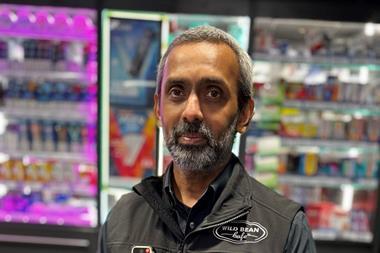Latest statistics show crime is still increasing. However, c-stores are leading the way in bucking this trend.
For anyone with an interest in the retail sector’s attempts to fight crime, the findings from two surveys released last week must have made depressing reading, with violent crime and violence against store staff both up on the previous year. The British Retail Consortium’s (BRC) crime survey for 2004 revealed that physical violence against staff was up by an alarming 14% on 2003, and that verbal abuse had risen by an even more staggering 35%.
The picture was just as bleak a few days later when the Home Office released its latest quarterly crime figures. They showed that violent crime had increased by 6% on the same period last year, while violent offences had risen from 301,100 to 318,200 in the three months to the end of June. The sense that things will have to get worse before they get better was brought home at the BRC’s annual crime conference last week.
Delegates had to endure representatives from police forces and retail groups such as Sainsbury’s, Argos and Marks & Spencer passing the buck back and forth over who was to blame for the new levels of crime. At the same time they continually questioned why certain crime reduction initiatives were not working and berated each other for a lack of involvement from both sides.
Winning the war.
However, if there is such a thing as a silver lining to these statistics, it is the hard work of c-stores in combating crime. According to the BRC’s survey, which included responses from 4,511 supermarkets and c-stores, incidents of customer theft, staff theft, burglary and robbery for these stores were all down in 2004 on yearly averages, with only incidents of criminal damage on the up.
Bells Stores security manager Barrie Hodgson puts the fall down to the more pro-active approach that most c-store operators have been taking to combat crime. He said: “There are a lot of good initiatives being developed in our sector now, which are being taken up by a number of operators. These include more detailed risk assessments, investment in equipment, white noise and classical music, and the increased passing of intelligence between different groups. This is not to say the problem of crime has been solved, far from it, but we are at least moving in the right direction.”
Southern Co-operative loss prevention manager Gareth Lewis believes that approaching and working with local police and crime reduction partnerships is still a major advantage for small retailers in tackling crime issues - an approach that’s a long way from the stand-offish attitudes highlighted at the BRC conference. Lewis, who in 2004 won C-Store’s first Zero Tolerance Award for his and his company’s work in combating retail crime, commented: “We have taken it upon ourselves to go to our local Crime and Disorder Reduction Partnerships and find out how we can get involved with them and how they can help us in all the communities our stores are based. From that we have been able to develop initiatives to combat underage drinking, anti-social behaviour and drug abuse.”
Lewis, like Hodgson, doesn’t pretend all the work has been done, and points out that the BRC’s figures also show that although customer theft in the c-store sector is down, the cost per incident almost doubled the yearly average in 2004 (£75 to £141), which is echoed in the rise in cost per robbery (£1,470 to £2,955).
However, while the rest of the retail sector scrambles around to apportion the blame for the latest crime rise, c-store retailers are quietly getting on with the day-to-day job of making their stores and staff safer.
For anyone with an interest in the retail sector’s attempts to fight crime, the findings from two surveys released last week must have made depressing reading, with violent crime and violence against store staff both up on the previous year. The British Retail Consortium’s (BRC) crime survey for 2004 revealed that physical violence against staff was up by an alarming 14% on 2003, and that verbal abuse had risen by an even more staggering 35%.
The picture was just as bleak a few days later when the Home Office released its latest quarterly crime figures. They showed that violent crime had increased by 6% on the same period last year, while violent offences had risen from 301,100 to 318,200 in the three months to the end of June. The sense that things will have to get worse before they get better was brought home at the BRC’s annual crime conference last week.
Delegates had to endure representatives from police forces and retail groups such as Sainsbury’s, Argos and Marks & Spencer passing the buck back and forth over who was to blame for the new levels of crime. At the same time they continually questioned why certain crime reduction initiatives were not working and berated each other for a lack of involvement from both sides.
Winning the war.
However, if there is such a thing as a silver lining to these statistics, it is the hard work of c-stores in combating crime. According to the BRC’s survey, which included responses from 4,511 supermarkets and c-stores, incidents of customer theft, staff theft, burglary and robbery for these stores were all down in 2004 on yearly averages, with only incidents of criminal damage on the up.
Bells Stores security manager Barrie Hodgson puts the fall down to the more pro-active approach that most c-store operators have been taking to combat crime. He said: “There are a lot of good initiatives being developed in our sector now, which are being taken up by a number of operators. These include more detailed risk assessments, investment in equipment, white noise and classical music, and the increased passing of intelligence between different groups. This is not to say the problem of crime has been solved, far from it, but we are at least moving in the right direction.”
Southern Co-operative loss prevention manager Gareth Lewis believes that approaching and working with local police and crime reduction partnerships is still a major advantage for small retailers in tackling crime issues - an approach that’s a long way from the stand-offish attitudes highlighted at the BRC conference. Lewis, who in 2004 won C-Store’s first Zero Tolerance Award for his and his company’s work in combating retail crime, commented: “We have taken it upon ourselves to go to our local Crime and Disorder Reduction Partnerships and find out how we can get involved with them and how they can help us in all the communities our stores are based. From that we have been able to develop initiatives to combat underage drinking, anti-social behaviour and drug abuse.”
Lewis, like Hodgson, doesn’t pretend all the work has been done, and points out that the BRC’s figures also show that although customer theft in the c-store sector is down, the cost per incident almost doubled the yearly average in 2004 (£75 to £141), which is echoed in the rise in cost per robbery (£1,470 to £2,955).
However, while the rest of the retail sector scrambles around to apportion the blame for the latest crime rise, c-store retailers are quietly getting on with the day-to-day job of making their stores and staff safer.





![PLAUK0125 Jacobs The Trussell Trust Portrait[53]](https://d2dyh47stel7w4.cloudfront.net/Pictures/274x183/6/4/1/322641_plauk0125jacobsthetrusselltrustportrait53_125111_crop.jpg)













No comments yet